Property Is About People
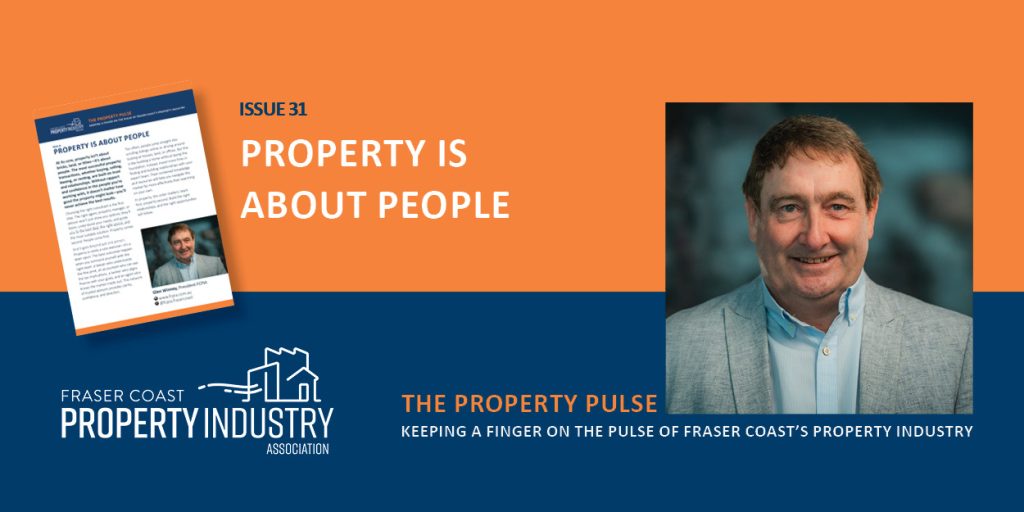
At its core, property isn’t about bricks, land, or titles—it’s about people. The most successful property transactions, whether buying, selling, leasing, or renting, are built on trust and relationships. Without rapport and confidence in the people you’re working with, it doesn’t matter how good the property might look—you’ll never achieve the best results. Choosing the right consultant is the first step. The right agent, property manager, or advisor won’t just show you options; they’ll listen, understand your needs, and guide you to the best deal, the right advice, and the most suitable solution. Property comes second. People come first. And it goes beyond just one person. Property is rarely a solo exercise—it’s a team sport. The best outcomes happen when you surround yourself with the right team: a lawyer who understands the fine print, an accountant who can see the tax implications, a banker who aligns finance with your goals, and an agent who knows the market inside out. This network of trusted advisors provides clarity, confidence, and direction. Too often, people jump straight into scrolling listings online or driving around looking at houses, land, or offices. But this is like building a home without laying the foundation. Instead, invest more time in finding and building relationships with your expert team. Their combined knowledge and resources will help you navigate the market far more effectively than searching on your own. In property, the order matters: team first, property second. Build the right relationships, and the right opportunities will follow.
Technophiles vs Luddites: The Great Property Divide
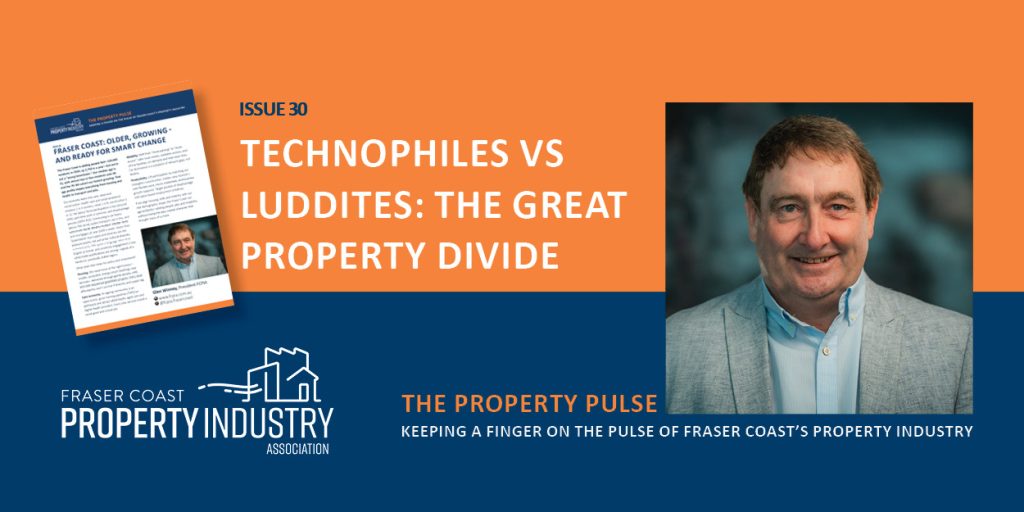
After 40-odd years in the property industry, I can’t recall a bigger divide than the one I’ve seen emerging over the last two years. It’s not about land supply or headworks charges this time — it’s about technology. And on the Fraser Coast, the property world now has two clear camps: the Luddites and the Technophiles. On one side, you’ve got the Luddites: the “we’ve always done it this way” crowd. They shuffle their papers, sharpen their pencils, and mutter darkly about the dangers of change. AI? “Too risky.” Digital tools? “Not accurate.” ChatGPT? “That’s cheating!” Their answer to progress is to double down on tradition — even if it means their systems creak louder than an old fax machine on dial-up. Then there are the Technophiles. This camp straps in like it’s a drag race at 100 miles an hour, grabbing every new app, AI tool, and platform that promises to make business faster, smarter, or more efficient. To them, ChatGPT isn’t a threat, it’s one of the greatest efficiency tools in decades. These folks are building workflows, generating insights, and finding ways to do in minutes what used to take days. The fun part? We’ve seen this movie before. Back in the early 1800s, the Luddites smashed the new textile machines to save their jobs. But history wasn’t on their side — technology marched on, and the world left them behind. So here’s the big question for the Fraser Coast property industry — from agents and lawyers to planners, surveyors, and builders: which camp will you pitch your tent in? Because like it or not, the future isn’t waiting. And if history’s any guide… we all know what happened to the Luddites.
Have We Lost the Art of Debate?
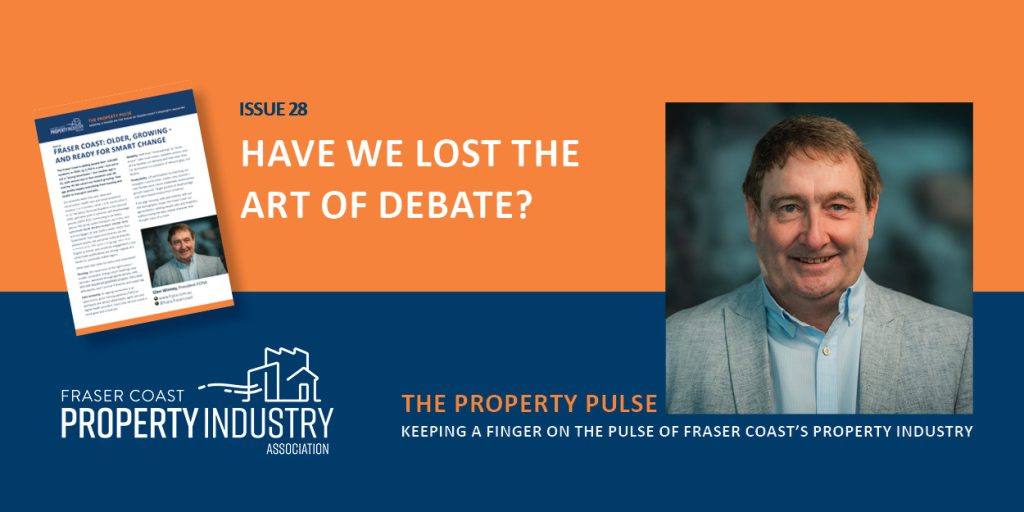
Freedom of opinion has always been a cornerstone of democracy. Yet in recent times — from Australian marches, politicians being demoted, tragic shootings in the US, to our very own public debates on Facebook — it feels like genuine debate has been replaced with shouting matches and personal attacks. Social media in particular has amplified division, where differing views are often “howled down” rather than discussed. Why does this matter to the property industry and Hervey Bay? Because if we want a bright future for our region, we need to create space for real conversation. Progress comes from open debate, the sharing of ideas, and the courage to think outside the box. When people are too afraid to voice fresh perspectives, we lose the chance to innovate. Hervey Bay is filled with talented people from across Australia and the world, many of whom have seen better planning, smarter infrastructure, and more successful approaches elsewhere. Yet too often they stay quiet, wary of being attacked personally instead of having their ideas debated on merit. This silence comes at a cost. NIMBYism (Not In My Backyard) is alive and well, and while everyone has a right to their say, shutting down change simply because it challenges personal preferences prevents good planning, better housing, and new jobs. Yes, there will always be projects we don’t like — but the bigger picture isn’t about the individual. It’s about what’s best for the region as a whole, for economic growth, and for the generations that will come after us. If we can restore the art of respectful debate, Hervey Bay will be better placed to shape a future that balances vision, progress, and community needs.
Retail Isn’t Dead – It’s Booming in Hervey Bay
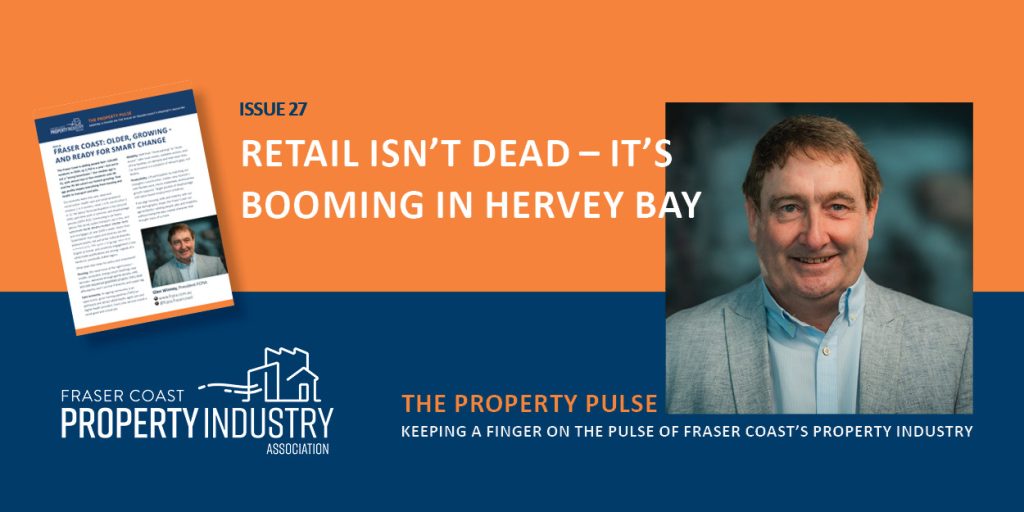
At the Fraser Coast Property Industry Association, we often hear the national headlines declaring “retail is dead.” In Hervey Bay, the opposite is true – retail is not just alive, it’s thriving and expanding faster than ever. The most visible change has been the surge in big-box retailing. The massive new Bunnings Warehouse has set a benchmark in scale and investment, drawing customers from across the region. Meanwhile, the old Bunnings site has been completely revitalised, now home to a line-up of national brands including Amart Furniture, Rebel, BCF, and more – proof that one retailer’s move has unlocked opportunity for many others. That momentum hasn’t stopped there. The new Anaconda centre has landed with strength, and alongside it, major brands such as Harris Scarfe and The Good Guys have expanded the retail mix, cementing Hervey Bay’s position as a regional shopping hub. On Main Street, new retail spaces are under construction, offering flexible formats for a new generation of businesses and creating further confidence in the Fraser Coast market. Yes, online shopping is here to stay – but in Hervey Bay, bricks-and-mortar retail is adapting, not retreating. From national operators to local lifestyle businesses, the shift is toward offering experience, convenience, and a reason to visit. Our community still wants to shop, dine, and gather in person – and they are doing so in ever-growing numbers. For landlords, tenants, and developers, the lesson is clear: retail in Hervey Bay isn’t dying; it’s transforming into something stronger. With population growth, lifestyle demand, and major national investment flowing in, the Fraser Coast is entering a new era of retail success. FCPIA: Championing growth, shaping opportunity, and backing the future of Fraser Coast retail.
Fraser Coast: older, growing – and ready for smart change
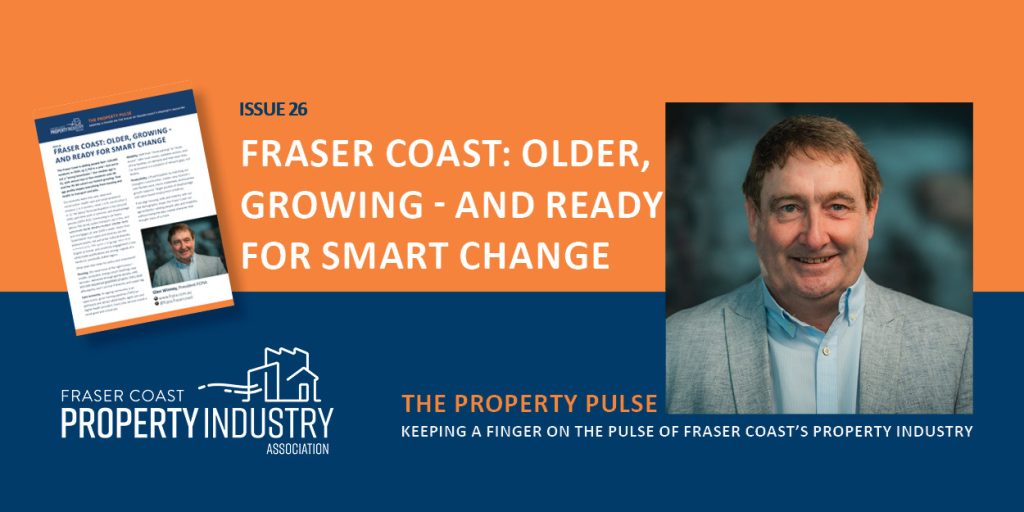
The Fraser Coast is adding people fast—120,685 residents in 2024, up 2,750 in a year—but we’re not a “young boomtown.” Our median age is 51, with almost two in five residents over 60 and the 70–84 cohort our fastest-growing. That age profile shapes everything from housing and health to transport and jobs. Our economy leans into care, retail and construction: health care and social assistance employs 1 in 5 workers, retail 1 in 9, construction 1 in 11. Yet labour force participation is low (around 44%), part-time work is common, and disadvantage persists (SEIFA 915). Commuting is car-heavy (about 74% drive), public transport use is tiny, and work-from-home remains modest. Median rents and mortgages sit near $300 a week—lower than Queensland—but supply and diversity are the pressure points, not just price. Cultural diversity is limited (only ~4% speak a language other than English at home), and university engagement is low, while trade qualifications are strong—signals of a hands-on, practically skilled region. What does that mean for policy and investment?Housing. We need more of the right homes—smaller, accessible, energy-smart dwellings near services—delivered through gentle density, infill, and well-sequenced greenfield projects. Entry-level affordability won’t survive if diversity and supply lag. Care economy. An ageing community is an opportunity: grow training pipelines (TAFE/uni pathways) and attract allied health, aged care and digital-health providers. Every new service is both a social good and a local job. Mobility. Shift from “more parking” to “more access”: safer local streets, walkable centres, end-of-trip facilities, on-demand and inter-town links. Car dominance is a symptom of network gaps, not destiny.Productivity. Lift participation by matching our strengths—construction, trades, care, tourism—with flexible work, micro-credentials, and business growth supports. Target pockets of disadvantage with place-based employment initiatives. If we align housing, skills and mobility with our real demographic shape, the Fraser Coast can age brilliantly—adding people, jobs and liveability without losing the easy coastal character that brought many of us here.
Hervey Bay 2046: A Growing City with a Promising Future

When I first presented growth forecasts to the Chamber over a year ago, I emphasised that the Fraser Coast’s future would be far bigger than many were planning for. The figures remain compelling, and they show both the challenge and the enormous opportunity before us. By 2046, the Fraser Coast is projected to welcome around 55,000 new residents—an increase of nearly 50% in just two decades. That’s the equivalent of adding another Maryborough to our region every 20 years. Importantly, the majority of this growth will be centred along the coast, with Hervey Bay as the dominant driver. To accommodate it, we’ll need approximately 1,200 new homes each year, yet current frameworks are only planning for about 700 annually. That gap—close to 19,000 homes by 2046—is not a crisis if we act now, but rather a chance to rethink how and where we build. Growth on this scale doesn’t just mean more houses. It means a larger workforce, stronger local businesses, and the ability to attract investment and infrastructure that would never come to a smaller community. But for this to happen, our planning needs to shift gears—embracing housing diversity, infrastructure upgrades, youth retention, and a long-term vision that balances lifestyle with opportunity. The Fraser Coast is blessed with natural beauty, lifestyle appeal, and a strong sense of community. If we get our thinking right today, these 55,000 new residents will not be a strain—they’ll be the energy that drives a new era of prosperity. It’s worth pausing to reflect: the decisions we make now will determine whether growth is something we react to, or something we harness to create a brighter, balanced future for the next generation.
🌟 FCPIA Mentoring Program – Coming Soon
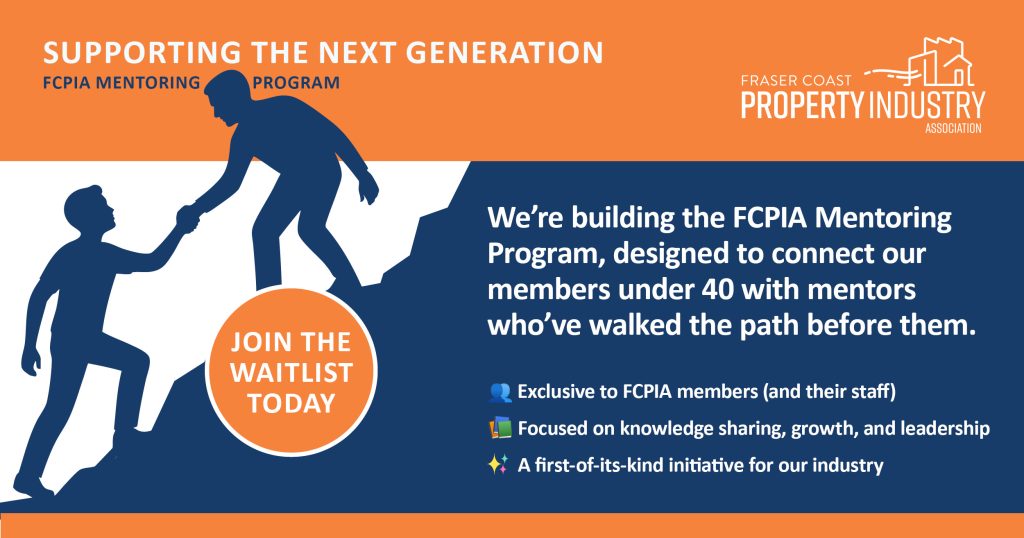
Connecting experience with ambition. The FCPIA Mentoring Program is designed to empower the next generation of property professionals by pairing younger members (under 40) with experienced mentors from within our association. This is about more than advice – it’s about connection, growth, and shaping the future of our industry together. 💡 Why join the waitlist? 🔒 Exclusive to FCPIA members and their employees. Join the waitlist below 👇
Is Car Parking the Silent Crisis?
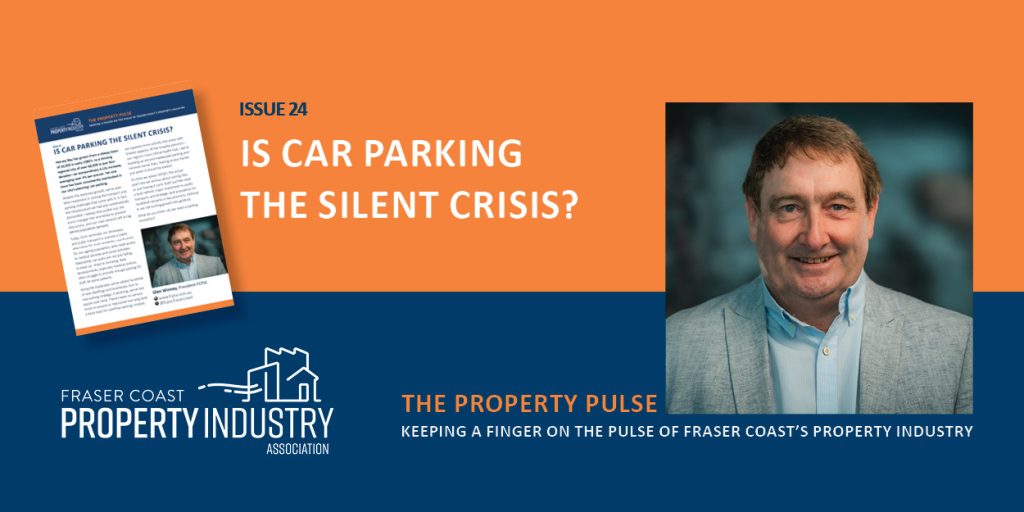
Hervey Bay has grown from a sleepy town of 16,000 in early 1980’s to a thriving regional city of over 68,000 in just four decades—an extraordinary 4.12x increase, averaging over 3% per annum. Yet one issue has been consistently overlooked in our city’s planning: car parking. Despite this explosive growth, we’ve seen little investment in solving the transport and parking challenges that come with it. In fact, the infrastructure we had was systematically dismantled—railway lines pulled out, the iconic Urangan Pier shortened to prevent ship access, and our road network left to lag behind population demand. Today, SUVs dominate our driveways, and public transport is scarcely a viable alternative for most residents – particularly for our ageing population, who need access to medical services and social activities. Meanwhile, car parks are not just failing to keep up—they’re shrinking. New developments, especially medical centres, often struggle to provide enough parking for staff, let alone patients. Along the Esplanade, we’ve added hundreds of new dwellings and businesses, but no real parking strategy. If anything, we’ve lost spaces over time. There’s been no serious move to acquire or repurpose low-lying land a block back for overflow parking. Instead, we squeeze more activity into areas with limited capacity. At the hospital precinct—our region’s most critical health hub—we’re building up around inadequate parking and minimal transit links, making access harder just when it should be easiest. It’s time we asked: What’s the actual plan? Are we serious about solving this, or just hoping it sorts itself out? We need a bold rethink: major investment in public transport, and strategic land acquisition for multilevel carparks in key precincts. Without it, we risk turning growth into gridlock. What do you think—do we need a parking revolution?
What Do We Want to Be Known For? Hervey Bay’s Identity Crisis
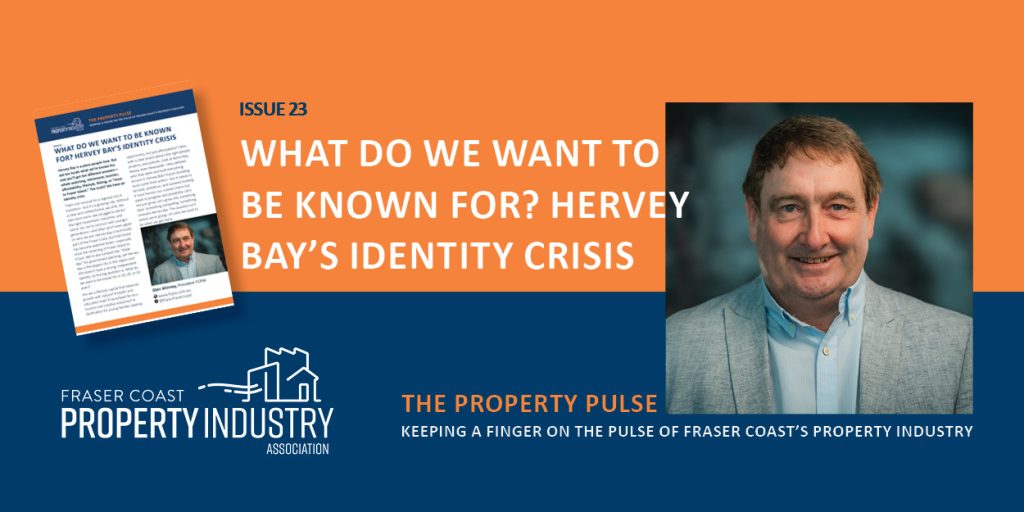
Hervey Bay is a place people love. But ask ten locals what we’re known for, and you’ll get ten different answers—whale watching, retirement, tourism, affordability, lifestyle, fishing, or “close to Fraser Island.” The truth? We have an identity crisis. That’s not unusual for a regional city in transition—but it’s a growing risk. Without a clear and unified brand, we drift. We plan short-term. We struggle to attract the right investment, industries, and talent. We fail to connect with younger generations—and often don’t even agree on who we are. Hervey Bay is technically part of the Fraser Coast, but that brand has become watered down—especially since the renaming of Fraser Island to K’Gari. We’re also lumped into “Wide Bay” for government planning, yet Hervey Bay is the largest city in the region and still doesn’t have a strong, independent identity. So the big question is: What do we want to be known for in 10, 20, or 50 years? Are we a lifestyle capital that balances growth with nature? A health and education hub? A launchpad for eco-tourism and creative industries? A destination for young families seeking opportunity, not just affordability? Cities with a clear brand attract the right people, projects, and policies. Look at Byron Bay, Noosa, even Newcastle—they defined who they were and built everything around it. Hervey Bay’s future branding must come from within—but it needs to be bold, ambitious, and outward-looking. It must honour our coastal charm but speak to progress and possibility. Let’s not just grow. Let’s grow into something clear. Something compelling. Something uniquely Hervey Bay. The question isn’t where we’re going—it’s who we want to be when we get there.
Women In Heels 2025

✨ Step into Something InspiringFCPIA invites you to join us for Women in Heels – an empowering afternoon celebrating the strength, style and spirit of the Fraser Coast’s women in business. This year, we’re mixing it up… No speaker announcements. No spoilers. Just trust us – the inspiration will come. 🗓️ Friday 29 August 2025📍 The Club House – Hervey Bay Golf Club🕦 Doors open 11:30am | Seated 12:00pm–3:00pm ✨ Expect an afternoon to:• Discover fresh perspectives on navigating change, leadership, and personal growth – with insights designed to spark action and deepen impact• Listen to stories that move you• Engage with like minded professionals• Learn practical tips for life, business, or leadership• Take away something meaningful for your own journey 🎶 Plus enjoy:• Live music• A one course luncheon• Raffle tickets, auction, and prizes for best heels (or boots for blokes!) Come curious. Leave recharged, realigned, and ready to lead – in your life or your business
Gentle Density – Hervey Bay’s Key to a Smarter, More Livable Future
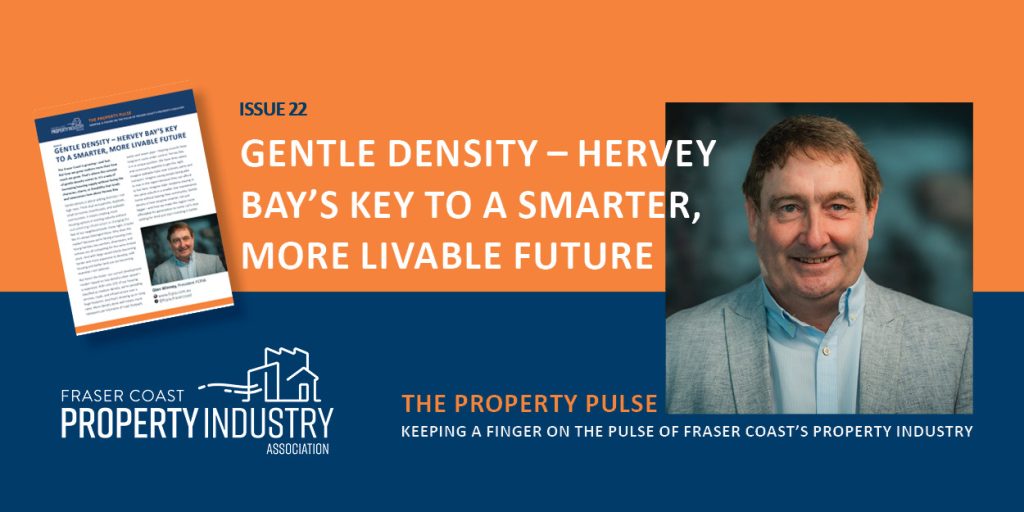
The Fraser Coast is growing—and fast. But how we grow matters more than how much we grow. That’s where the concept of gentle density comes in. It’s a way of increasing housing supply without losing the character, charm, or liveability that locals and newcomers love about Hervey Bay. Gentle density is about adding diversity—not high-rises. Think dual occupancies, duplexes, small lot homes, townhouses, and walkable communities. It means creating more housing options in existing suburbs without overwhelming infrastructure or changing the feel of our neighbourhoods. Done right, it looks like it’s always belonged there. Why does this matter? Because we’re facing a housing crisis. Young families, key workers, downsizers, and retirees are all competing for the same limited stock. And with large vacant blocks becoming harder and more expensive to develop, infill housing and better land use are becoming essential—not optional. But here’s the kicker: our current development model—based on low-density urban sprawl—is expensive. With only 12% of our housing classified as medium density, we’re spreading services, roads, and infrastructure over a huge footprint. And that’s showing up in rising rates. More density done well means more ratepayers per kilometre of road, footpath, water and sewer pipe—helping councils keep long-term costs under control. Hervey Bay is in a unique position. We have time, space, and community appetite to get this right. Imagine walkable hubs near schools, parks and transport. Imagine young people being able to stay in the region because they can afford to live here. Imagine older residents staying in the same suburb in a smaller, low-maintenance home without leaving their community. Gentle density is how we grow smarter, not just bigger—and how we make this region more affordable for generations to come.
Why the Fraser Coast Needs a 50-Year Vision – Not a 5-Year Budget
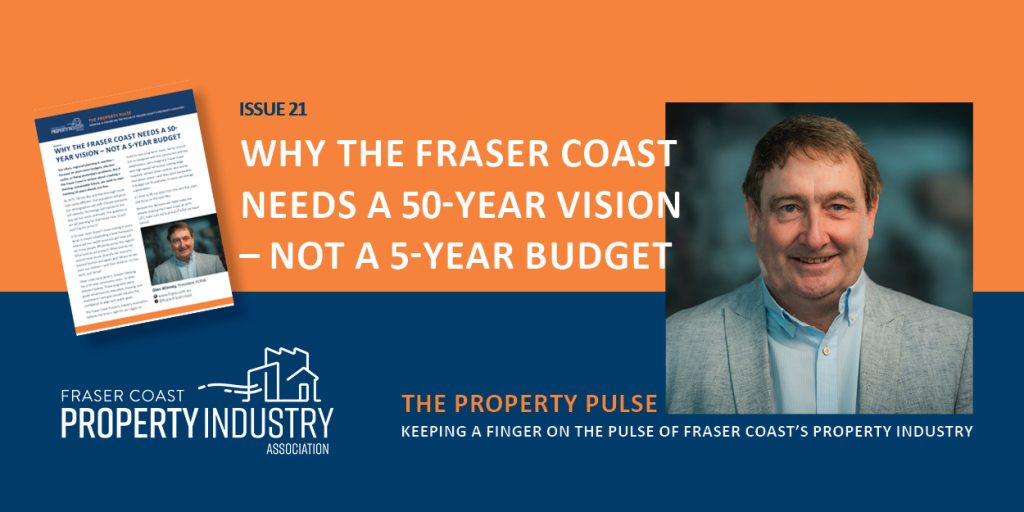
Too often, regional planning is reactive—focused on short-term budgets, election cycles, or fixing yesterday’s problems. But if the Fraser Coast is serious about creating a thriving, sustainable future, we need to start thinking 50 years ahead, not five.By 2075, Hervey Bay and Maryborough could look vastly different. Our population will grow. Our demographics will shift. Climate pressures will intensify. Technology will transform the way we live, work, and build. The question is: are we planning for that future now, or just patching the present? A 50-year vision doesn’t mean locking in every detail. It means establishing a bold framework: where will our health precincts go? How will we move people efficiently across the region? What land do we protect? What land do we unlock? How do we diversify our economy beyond tourism and aged care? Where do we want our children—and their children—to live, work, and thrive? Other cities have done it. Greater Geelong has a 50-year community vision. So does Western Sydney. These long-term plans guide infrastructure, education, housing, and investment—and give private industry the confidence to align with public goals. The Fraser Coast Property Industry Association believes the time is right for our region to build its own long-term vision, led by council but co-designed with the community and key stakeholders. Let’s imagine a Fraser Coast with high-speed rail access, cutting-edge hospitals, vibrant urban centres, and world-class green space—and then work backwards. A budget can fix potholes. A vision can change a generation. It’s time to lift our eyes from the next five years and focus on the next fifty.Because the decisions we make today are already shaping the Fraser Coast of 2075. Let’s make sure we’re proud of what we leave behind.
Housing for Who? Why We Need More Than Just Big Blocks
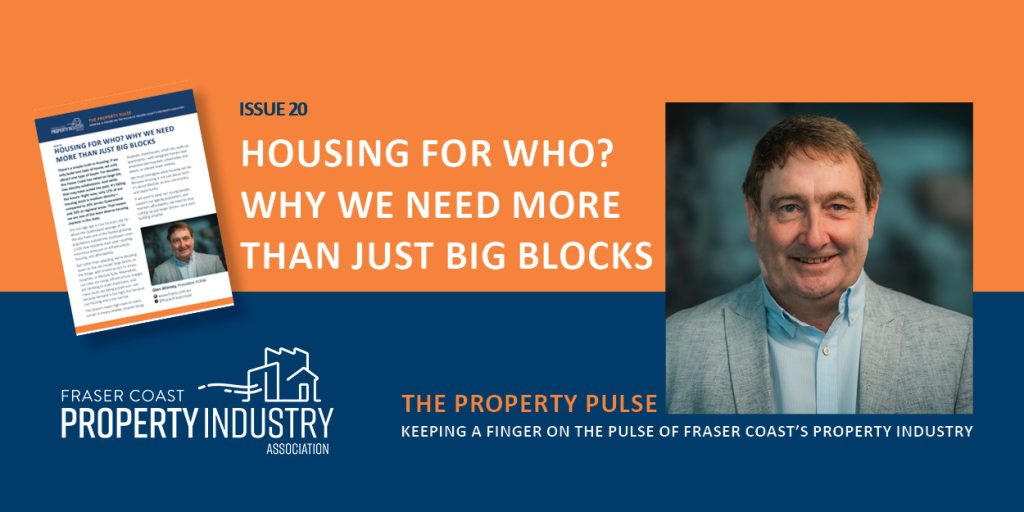
There’s a simple truth in housing: if we only build one type of house, we only attract one type of buyer. For decades, the Fraser Coast has relied on large-lot, low-density subdivisions. And while that may have suited the past, it’s failing the future. Right now, only 12% of our housing stock is medium density – compared to 26% across Queensland and 24% in regional areas. That means we are one of the least diverse housing markets in the state. Our average age is now 51 years old, far above the Queensland average of 38. We also have one of the fastest growing populations outside the southeast—over 2,500 new residents each year—putting enormous pressure on infrastructure, housing, and affordability. But rather than adapting, we’re doubling down on the old model: large blocks on the fringe, with limited access to shops, hospitals, or lifestyle hubs. Meanwhile, our rates are rising, infrastructure charges are climbing to state maximums, and many locals are being priced out – not because demand is too high, but because our housing mix is too narrow. This doesn’t mean high-rises on every corner. It means smaller, smarter living: duplexes, townhouses, small lots, walk-up apartments—well-designed homes near amenities like hospitals, universities, the beach, or vibrant town centres. We must reimagine what housing can be. Because housing is not just about land—it’s about lifestyle, access, community, and opportunity. If we want to keep our young people, support our ageing population, and maintain affordability, we need to stop cutting up just larger blocks—and start building smarter.
FCPIA – 15 July 2025 – MEDIA RELEASE
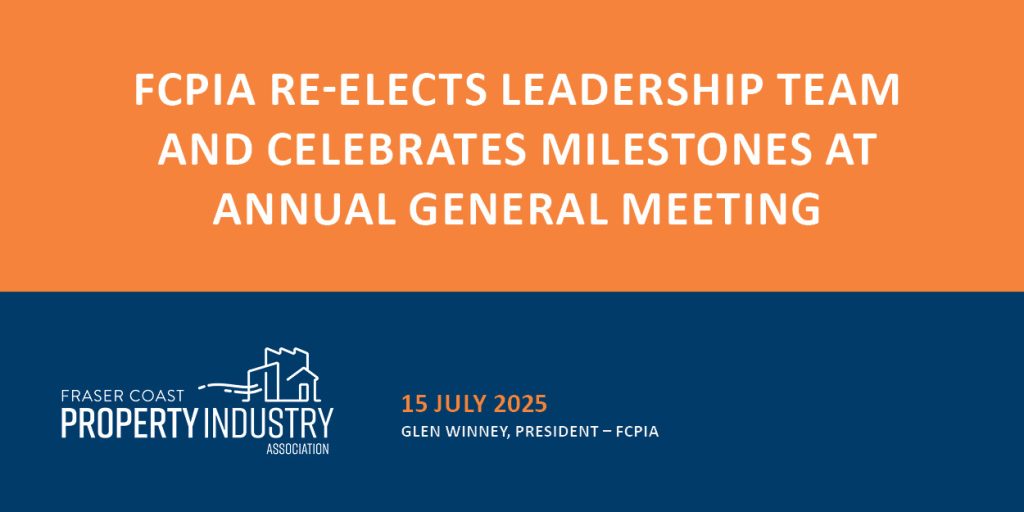
Fraser Coast Property Industry Association Re-Elects Leadership Team and CelebratesMilestones at Annual General Meeting. The Fraser Coast Property Industry Association (FCPIA) held its Annual General Meeting on 15July 2025 at the Fraser Room, Boat Club Hervey Bay. The meeting was attended by a strongrepresentation of members and featured the re-election of the entire Management Committee foranother term. We are pleased to confirm the re-election of Glen Winney as President, David Buckley as VicePresident, Peter Bennet as Treasurer, and Maggie Brennan as Secretary. Kim Carter and CameronSonter continue their roles on the Executive Committee, reflecting the team’s unity and consistentleadership. In addition to the Executive Committee, the FCPIA’s two subcommittees – Policy (Ward Vietch,Kane Macready, Jemma Derksen, Robert Mackay) and Events & Marketing (Ingrid Gorissen) – alsoremain unchanged. The Policy Subcommittee continues to tackle critical infrastructure andplanning issues, while the Events Committee continues to deliver standout professional andcommunity events. President Glen Winney highlighted the Association’s momentum over the past 12 months.Membership has grown to nearly 100 corporate members from a diverse mix of industries. TheAssociation delivered several successful workshops, including the popular Development Lifecyclesession, a Q&A with top accountants, and an energising session with guest speaker Allan Pease.The flagship “Women in Heels” event raised around $10,000 for Fraser Coast Mates and returnsthis August. FCPIA’s policy influence continues to grow through the strength of its Memorandum ofUnderstanding (MOU) with Council. The Association is actively contributing to policy on planningschemes, infrastructure charges, housing diversity, and more. Its 2025/26 Priority Projects listoutlines key regional initiatives the FCPIA is advocating for. Weekly opinion columns and active digital engagement have kept the community informed, andthe Association remains passionate about youth retention as a long-term economic andcommunity goal. Glen Winney commented, “It’s our growing and engaged membership that gives us influence withlocal, state and federal governments. I encourage every member to invite just one other businessto join – because the louder our collective voice, the stronger our region’s future.” For further information, please contact:Glen WinneyPresident, Fraser Coast Property Industry AssociationE: admin@fcpia.com.au
What If Our Retail Strips Were Our Greatest Showcase?
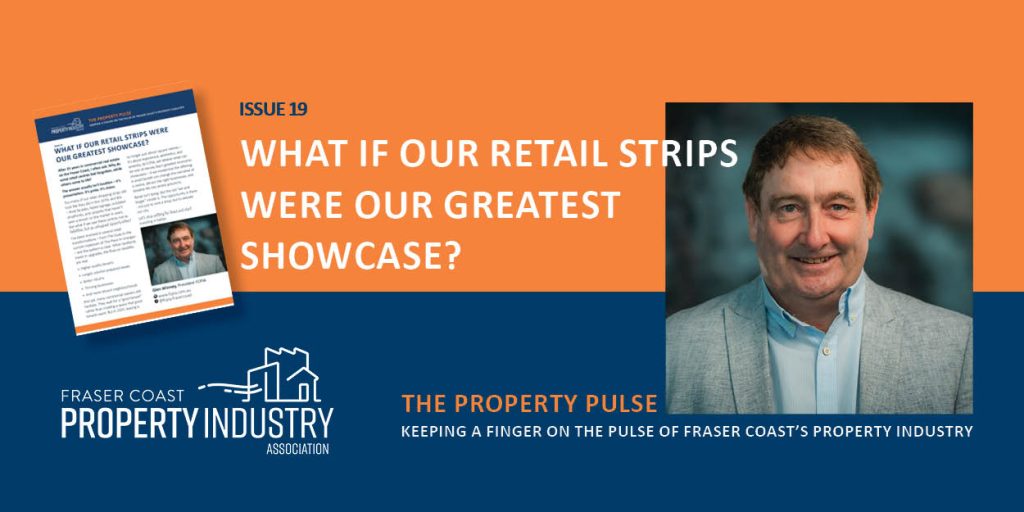
After 25 years in commercial real estate on the Fraser Coast, I often ask: Why do some retail centres feel forgotten, while others come to life? The answer usually isn’t location – it’s presentation. It’s pride. It’s vision. Too many of our older shopping strips still look like they did in the 1970s and 80s – tired facades, faded signage, outdated shopfronts, and carparks that haven’t seen a broom or line marker in years. But what if we saw these centres not as liabilities, but as untapped opportunities? I’ve been involved in several retail transformations – from The Quay to the current makeover of The Place in Urangan – and the pattern is clear. When landlords invest in upgrades, the flow-on benefits are real:– Higher quality tenants– Longer, solicitor-prepared leases– Better returns– Thriving businesses– And more vibrant neighbourhoods And yet, many commercial owners still hesitate. They wait for a “good tenant” rather than creating a space that good tenants want. But in 2025, leasing is no longer just about square metres – it’s about experience, aesthetics, and amenity. At FCPIA, we believe retail can be one of Hervey Bay’s greatest economic showcases – if we modernise the offering. A small facelift can change the narrative of a centre, attract the right businesses, and breathe life into entire precincts. Retail isn’t dying. But the old “set and forget” model is. The opportunity is there – not just to rent a shop, but to elevate our city. Let’s stop settling for tired and start investing in better.
FCPIA AGM & Workshop #3
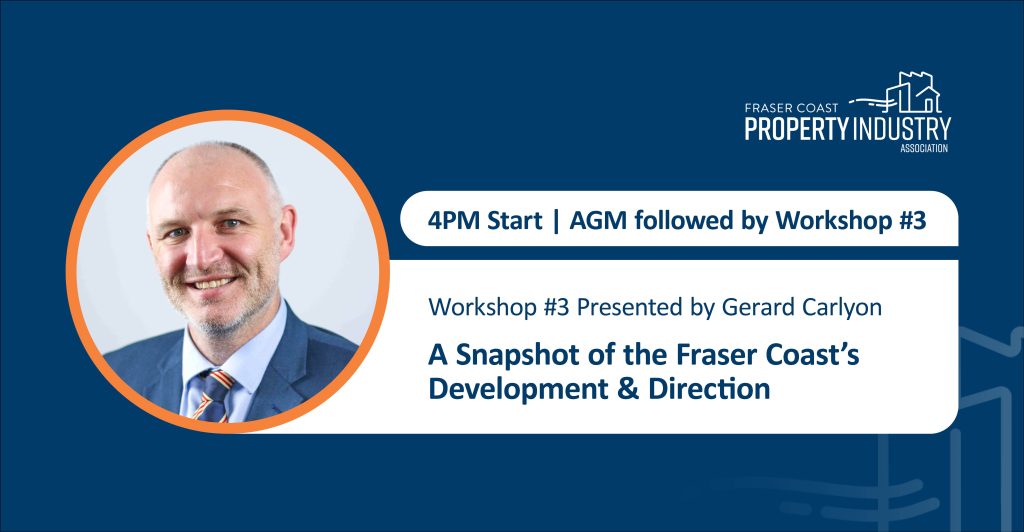
All FCPIA Members are invited to the 2025 Annual General Meeting, followed by Workshop #3 presented by Gerard Carlyon. Tuesday 15 July 2025 4:00 PM Start | Hervey Bay Boat Club – Fraser Room BOOK NOW: https://www.trybooking.com/events/landing/1431492 Workshop #3: A Snapshot of the Fraser Coast’s Development & Direction Join us for an exclusive FCPIA event as Fraser Coast Regional Council Deputy CEO Gerard Carlyon shares insights into the development of the region’s new Economic Development Strategy. This session will explore:• How industry consultation is shaping Council’s strategy• The demographic shifts driving housing and infrastructure needs• Opportunities for developers, builders, consultants, and agents• Why a united voice from the property sector is critical to unlocking funding **Please note: This event is restricted to FCPIA Members. Only financial members for 2025–2026 are eligible to vote.*
Aqua View
www.aquavue.com.au
Tribecca
www.tribeca.com.au
WIN PROJECTS
www.winprojects.com.au
VISION PROPERTY MANAGEMENT
www.visionpropertyhb.com.au
VIVERE HOMES
www.viverehomes.com.au
Vicki Squires Real Estate
www.vsrealty.au
URBAN PLANET TOWNPLANNING CONSULTANTS
www.urbanplanet.com.au
Uniqsol
www.uniqsol.com.au
UNIVERSAL HOME IMPROVEMENTS
herveybaypatiosandshed.com.au
ULTON HERVEY BAY
www.ulton.net
TRANQUILITY MEDIA
www.tranquilitymedia.com.au
The Bay Appartments
www.thebayapartments.com.au
SHABRAE INVESTMENTS
www.timbersreserve.com.au
SANDY STRAITS PEST CONTROL
sandystraitspestcontrol.com.au
STYLE IT BY VICTORIA
www.styleit.net.au
SunQ
www.myfirstpropertyfinance.com
SPRAKE REAL ESTATE
www.sprakerealestate.com.au
Simply Real Estate Fraser Coast
simplyrealestatefrasercoast.com
RTJR Properties
www.rtjrproperties.com.au
REGIONAL ECOSYSTEMS MAPPING CONSULTANCY
REGIONALECOSYSTEMSMAPPINGCONSULTANCY
Realway Real Estate
www.realwayherveybay.com.au
Property Wealth QLD
propertywealthqueensland.com.au
Property Momentum
Property Momentum
PW ARCHITECTURE
www.primeagents.com.au
PRIME AGENTS HERVEY BAY
www.primeagents.com.au
PRAESCIUS
www.pfinancial.com.au
PINNACLE HERVEY BAY
www.pinnacleherveybay.com
NATIONAL AUSTRALIA BANK
www.nab.com.au
My First Property
www.myfirstpropertyfinance.com
MIDCOAST AIRCONDITIONING &COMMERCIAL REFRIGERATION
www.midcoastair.com
MITCHELLS REALTY
www.mitchellsrealty.com.au
MICHELLE LOCKWOODREAL ESTATE
www.expaustralia.com.au
McDuff & Guilfoyle Lawyers
www.hblawyers.com.au
MASTER BUILDERS QUEENSLAND
www.mbqld.com.au
MARKS & PARTNERS PROPERTY
www.markspartners.com.au
Maddigans Seafood
www.madigansseafood.com.au
LAW ESSENTIALS
www.lawessentials.net.au
Latitude 25
www.visitlatitude25.com.au
Landscaping Design Hervey Bay
www.landscapingherveybay.com
KONTRA TECH PTY LTD
www.bigwilliplumbing.com.au
KIRBO CONTRACTINGPTY LTD
www.kirbo.com.au
KINGSTON HB PTY LTD
www.kingstonherveybay.com.au
KERRY CAMPBELLHOME PTY LTD
www.kerrycampbell.com.au
JAC CIVIL PTY LTD
www.jaccivil.com.au
IPN VALUERS HERVEY BAY
www.ipnvaluers.com.au
IN SITE SJC
www.insitesjc.com.au
HUNTINGDALE CENTRAL
www.huntingdalecentral.com.au
HERRON TODDWHITE CQ
www.htw.com.au
GO FURTHER FINANCE
gofurtherfinance.com.au
GRAND CIVIL
www.grandcivil.com.au
G DEVELOPMENTS
www.gdevelopments.com.au
FAUNT PROPERTY GROUP
www.fauntpropertygroup.com
Exp Reality
www.expaustralia.com.au
ENGINEERS PLUS
www.engineersplus.com.au
DSB PROPERTYMANAGEMENT
www.dsbpm.com.au
CSG LAW
www.csglaw.com.au
CULLEN & COUPERPTY LTD
www.cullenc.com.au
CLM CHARTEREDACCOUNTANTS
www.clmaccountants.com.au
Construct Build Renovate
www.cbrqld.com
COASTYLES PROPERTY
www.coastyles.com
CARTER COOPERREALTY
www.cartercooperrealty.com.au
By The rules – Hervey Bay
www.ByTheRules.com.au Hervey Bay
BRYNE BROS CONCRETE
www.byrnebros.com.au
BURCHILLS ENGINEERING
www.burchills.com.au
Bungalow Homes
bungalowcustomhomes.com.au
Bendigo Bank
www.bendigobank.com.au
BELL DIXON BUTLER
www.bdblawyers.com.au
BOQ HERVEY BAY
www.boq.com.au
BESPOKE REALTY
www.rrrr.com.au
BARLOW SHELLEY
www.barlowshelley.com.au
Azura Building Group
www.azurabuildinggroup.com.au
ANZ
www.anz.com.au
ALLEN PROPERTY
www.allenproperty.com.au
AHC Limited

www.ahc.com.au
ACQUACO DESIGN GROUP

www.acquaco.com.au
ACTIVE AGENTS HERVEY BAY

www.activeagents.com.au
Community Intelligence: The Power We Hold Together
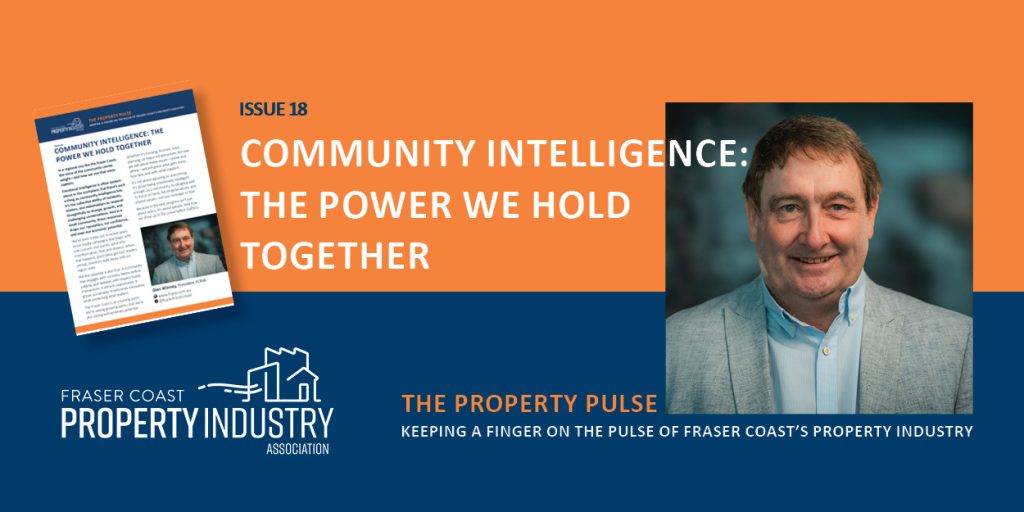
In a regional city like the Fraser Coast, the voice of the community carries weight—and how we use that voice matters. Emotional intelligence is often spoken about in the workplace, but there’s such a thing as community intelligence too. It’s the collective ability of residents, leaders, and stakeholders to respond thoughtfully to change, growth, and challenging conversations. And in a small community, those responses shape our reputation, our confidence, and even our economic potential. We’ve seen it play out in recent years: social media campaigns that begin with one concern and quickly spiral into misinformation, fear, and division. When that happens, good ideas get lost, leaders retreat, investors walk away, and our region stalls. But the opposite is also true. A community that engages with curiosity, listens before judging, and debates with respect builds momentum. It attracts opportunity. It grows sustainably. It welcomes innovation while protecting what matters. The Fraser Coast is at a turning point. We’re seeing growing pains—but we’re also seeing extraordinary potential. Whether it’s housing, tourism, town planning, or major infrastructure, the way we talk about these issues—online and offline—will influence what gets done, how fast, and with what support. It’s not about agreeing on everything. It’s about being emotionally intelligent enough, as a community, to disagree well. To focus on facts, future generations, and shared values—not just nostalgia or fear. Because in the end, progress isn’t just about policy. It’s about people. And how we show up in the conversation matters.
Flying High: Air Connectivity Fuels Fraser Coast’s Future
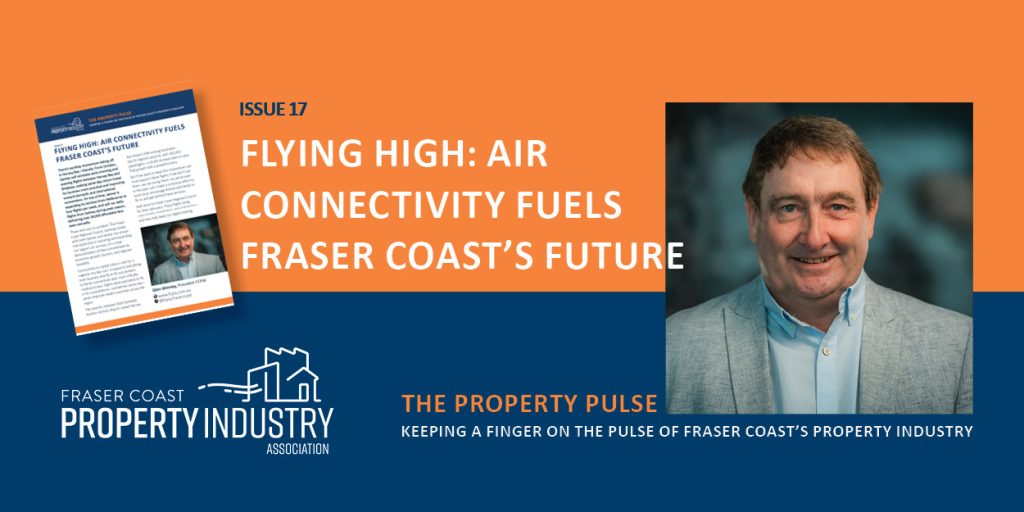
There’s exciting momentum taking off in Hervey Bay—literally. From October, Qantas will reinstate early morning and evening flights between Hervey Bay and Brisbane, making same-day return travel for business more practical and improving onward domestic and international connections. On top of that, Jetstar is expanding its services from Melbourne to four flights per week, and will run daily flights from Sydney during peak season, delivering over 38,000 affordable fare seats annually. These wins are no accident. The Fraser Coast Regional Council, working closely with both Qantas and Jetstar, has shown real leadership in restoring and expanding our region’s air services. It’s a clear demonstration of their commitment to economic growth, tourism, and regional liveability. Connectivity to capital cities is vital for a regional city like ours. It supports everything from business and fly-in-fly-out workers to family connections and, most critically, medical access. Flights allow specialists to fly in for consultations—sometimes same-day—which improves health outcomes across the region. The recently released 2024 Domestic Aviation Activity Report ranked Hervey Bay Airport 29th among Australia’s top 50 regional airports, with 183,300 passengers—a 24.6% increase year-on-year. That growth tells a powerful story. But if we want to keep this momentum, we must support these flights. If we don’t use them, we risk losing them—as we’ve seen in the past. Let’s make a conscious effort to book local, encourage friends and family to fly in, and get behind these services. Well done to Fraser Coast Regional Council for their advocacy. These flights bring opportunity, investment, and connection—and they help keep our region soaring.
Nostalgia Isn’t a Strategy
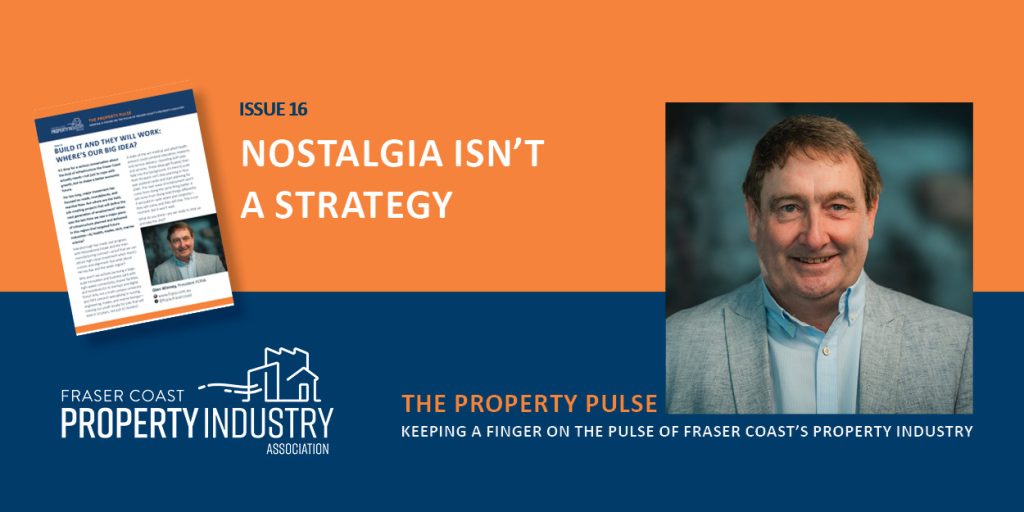
It’s comforting to look back. To remember “how we used to do things” and preserve the parts of Hervey Bay that made it special. But when it comes to shaping the future, nostalgia can’t be the strategy. The next generation doesn’t want to simply inherit the past—they want to shape what comes next. And right now, change is happening faster than ever. From four-day work weeks to remote offices, the very idea of how and where we work is shifting. AI is on track to become the greatest disrupter of our era, affecting everything from business models to transport, health care, education, and entertainment. The facilities we build now—whether for work, sport, learning, or leisure—need to reflect where we’re going, not just where we’ve been. It’s not enough to build “what we’ve always had.” We need to be designing cities and infrastructure that embrace technology, flexibility, and a more dynamic way of living. That means challenging the idea that preserving the past is always the best path. Yes, history matters—but progress requires courage. Courage to invest in innovation, plan for AI integration, rethink outdated zoning, and design environments that meet the expectations of tomorrow’s workers, students, and families. The Fraser Coast can be a leader in this shift—but only if we choose to evolve. The rest of the world is moving. Will we keep up, or keep looking backwards? Let’s build a future the next generation will be proud to call their own.
Build It and They Will Work Where’s Our Big Idea?
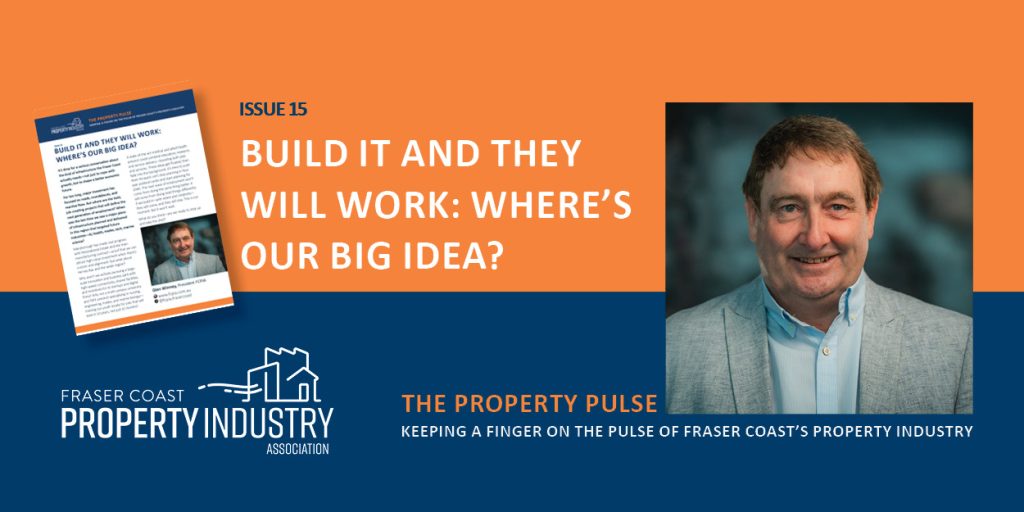
It’s time for a serious conversation about the kind of infrastructure the Fraser Coast actually needs—not just to cope with growth, but to shape a better economic future. For too long, major investment has focused on roads, roundabouts, and reactive fixes. But where are the bold, job-creating projects that will define the next generation of employment? When was the last time we saw a major piece of infrastructure planned and delivered in this region that targeted future industries—AI, health, trades, tech, marine science? Maryborough has made real progress with Moonaboola Estate and the train manufacturing contract—proof that we can attract high-value investment when there’s a vision and alignment. But what about Hervey Bay and the wider region? Why aren’t we actively pursuing a large-scale innovation and business park with high-speed connectivity, shared facilities, and incentives for AI startups and digital firms? Why not a multi-campus university and TAFE precinct specialising in nursing, engineering, trades, and marine biology—training our youth locally for jobs that will exist in 10 years, not just 10 months? A state-of-the-art medical and allied health precinct could combine education, research, and service delivery—boosting both jobs and services. These ideas get floated, then fade into the background. It’s time to push them forward. Let’s stop planning in four-year political cycles and start planning for 2040. The next wave of employment won’t come from doing the same thing better. It will come from doing bold things differently. If we build it—with intent and creativity—they will come, and they will stay.
Who is FCPIA—and Why It Matters
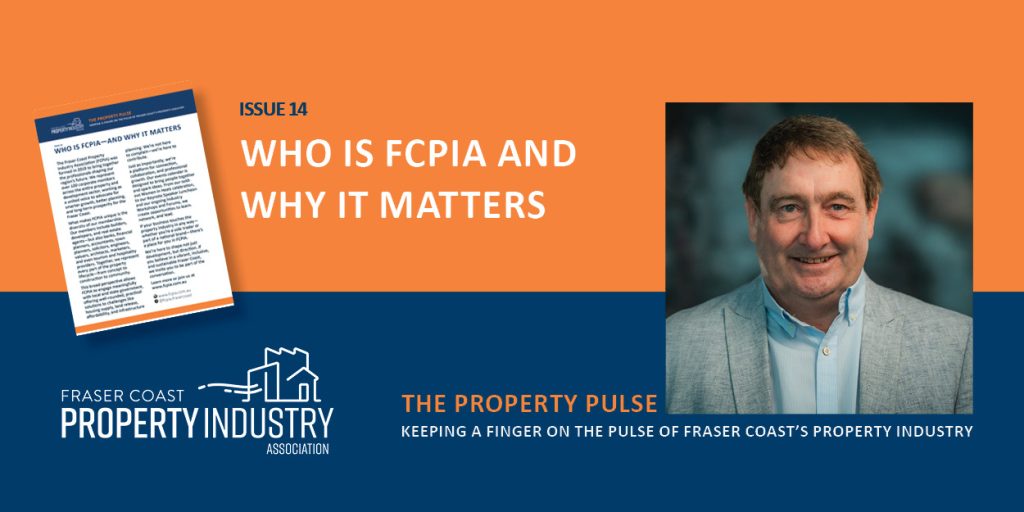
Who is FCPIA—and Why It Matters The Fraser Coast Property Industry Association (FCPIA) was formed in 2019 to bring together the professionals shaping our region’s future. We represent over 100 corporate members across the entire property and development sector, working as a united voice to advocate for smarter growth, better planning, and long-term prosperity for the Fraser Coast. What makes FCPIA unique is the diversity of our membership. Our members include builders, developers, and real estate agents—but also banks, financial planners, accountants, town planners, solicitors, engineers, valuers, architects, marketers, and even tourism and hospitality providers. Together, we represent every part of the property lifecycle—from concept to construction to community. This broad perspective allows FCPIA to engage meaningfully with local and state government, offering well-rounded, practical solutions to challenges like housing supply, land release, affordability, and infrastructure planning. We’re not here to complain—we’re here to contribute. Just as importantly, we’re a platform for connection, collaboration, and professional growth. Our events calendar is designed to bring people together and spark ideas. From our sold-out Women in Heels celebration, to our Keynote Speaker Luncheon and our ongoing Industry Workshops and Forums, we create opportunities to learn, network, and lead. If your business touches the property industry in any way—whether you’re a sole trader or part of a national brand—there’s a place for you in FCPIA. We’re here to shape not just development, but direction. If you believe in a vibrant, inclusive, and sustainable Fraser Coast, we invite you to be part of the conversation. 👉 Learn more or join us at https://fcpia.com.au/register/
Fraser Coast: A Snapshot of a Region in Transition
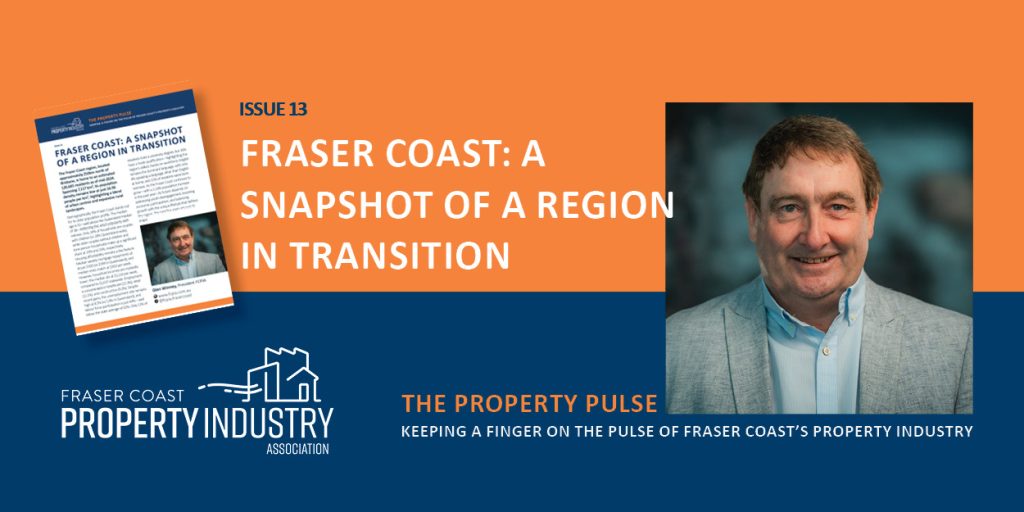
The Fraser Coast region, located approximately 250km north of Brisbane, is home to an estimated 120,685 residents as of mid-2024. Spanning 7,117 km², its population density remains low at just 16.96 people per km², highlighting a blend of urban centres and expansive rural landscapes. Demographically, the Fraser Coast stands out for its older population profile. The median age is 51—well above the Queensland median of 38—reflecting the area’s popularity with retirees. Only 19% of households are couples with children (vs 28% Queensland-wide), while older couples without children and lone-person households make up a significant share at 19% and 25%, respectively. Housing affordability remains a key feature. Median weekly mortgage repayments sit at just $300 (vs $399 in Queensland), and median rents match at $300 per week. However, household incomes are markedly lower: the median sits at $1,114 per week, compared to $1,637 statewide. Employment is concentrated in healthcare (21.3%), retail (11.1%), and construction (9.2%). Despite recent gains, the unemployment rate remains high at 8.5% (vs 5.4% in Queensland), and labour force participation is just 44%—well below the state average of 62%. Only 11% of residents hold a university degree, but 26% have a trade qualification—highlighting the region’s skilled, hands-on workforce. English remains the dominant language, with only 4% speaking a language other than English at home, and 15% of residents were born overseas. As the Fraser Coast continues to grow—with a 2.33% population increase in the past year—its future depends on addressing youth disengagement, boosting economic participation, and balancing growth with the unique lifestyle that defines the region.
Hervey Bay: Growth, Opportunity, and the Road Ahead
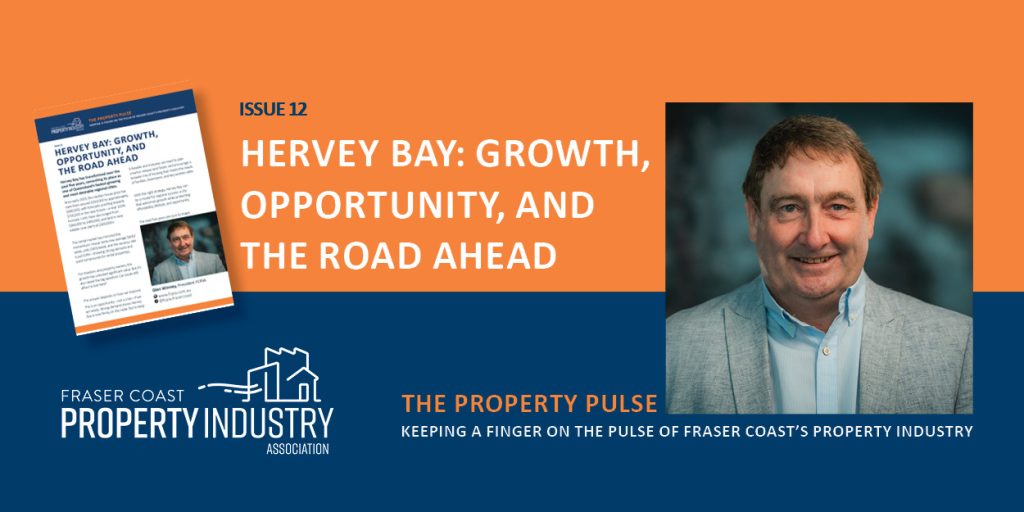
Hervey Bay has transformed over the past five years, cementing its place as one of Queensland’s fastest-growing and most desirable regional cities. Since early 2020, the median house price has risen from around $350,000 to approximately $680,000, with forecasts pointing towards $700,000 in the near future—a near 100% increase. Units have also surged from $264,000 to $490,000, and land in new estates now starts at $300,000+. The rental market has mirrored this momentum. House rents now average $600/week, units $465/week, and the vacancy rate is just 0.9%—showing strong demand and quick turnarounds for rental properties. For investors and property owners, this growth has unlocked significant value. But it’s also raised the big question: Can locals still afford to live here? The answer depends on how we respond. This is an opportunity—not a crisis—if we act wisely. Strong demand shows Hervey Bay is now firmly on the radar. But to keep it liveable and inclusive, we need to plan smarter, release land faster, and encourage a broader mix of housing that meets the needs of families, downsizers, and key workers alike. With the right strategy, Hervey Bay can be a model for regional success: a city that welcomes growth while protecting affordability, lifestyle, and opportunity. The next five years are ours to shape.
The Fraser Coast in Numbers: What Happens If We Stay on This Path?
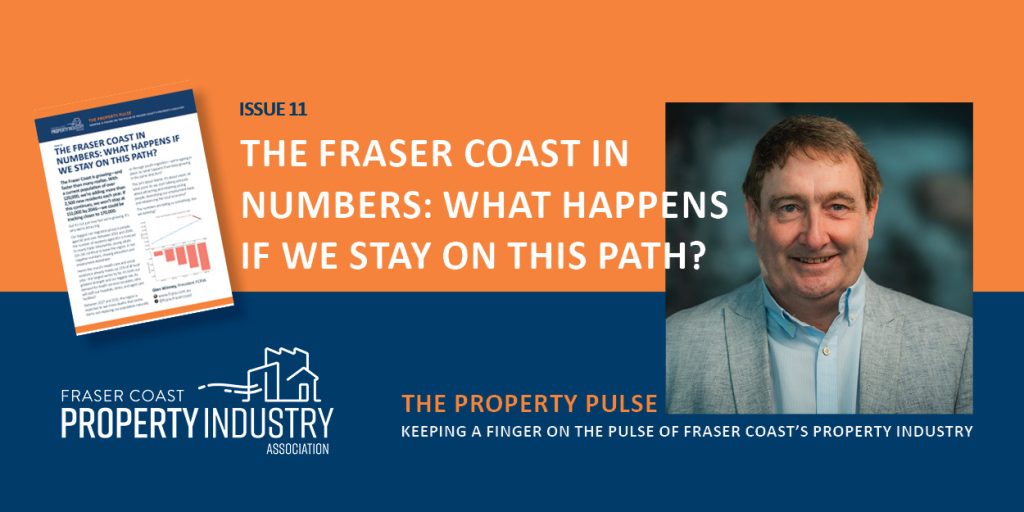
The Fraser Coast is growing—and faster than many realise. With a current population of over 120,000, we’re adding more than 2,500 new residents each year. If this continues, we won’t stop at 151,000 by 2046—we could be tracking closer to 170,000. But it’s not just how fast we’re growing. It’s who we’re attracting. Our biggest net migration group is people aged 60 and over. Between 2021 and 2046, the number of residents aged 85+ is forecast to nearly triple. Meanwhile, young adults (18–24) continue to leave the region, in net negative numbers, chasing education and employment elsewhere. Here’s the crunch: Health care and social assistance already makes up 21% of all local jobs—the largest sector by far. It’s both our greatest strength and our biggest risk. As demand for health services escalates, who will staff our hospitals, clinics, and aged care facilities? Between 2027 and 2031, the region is expected to see more deaths than births. We’re not replacing our population naturally or through youth migration—we’re ageing in place. So what happens if we keep growing in the same direction? This isn’t about blame. It’s about vision. At what point do we start talking seriously about attracting and retaining young people, diversifying our employment base, and rebalancing the local economy? The numbers are telling us something. Are we listening?
